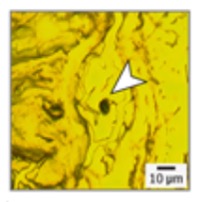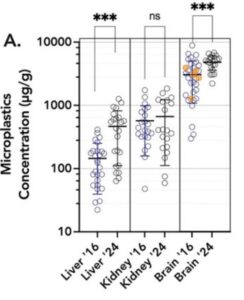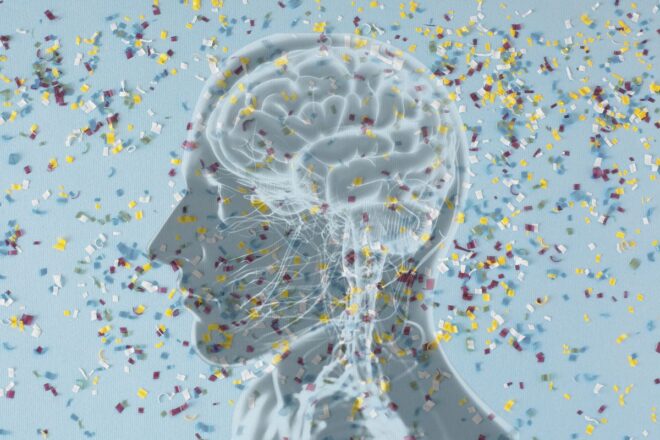One of the major changes in our environment over the last two decades has been the huge increase in plastic pollution. Does plastic get into our brain, and what do we know about what it is doing there? This article is a part of a series exploring how our growing exposure to environmental toxins is contributing to the mental health crisis in younger generations.
Two recent studies were the first to detect microplastics in the human brain
Microplastics are tiny plastic particles with size less than 5 mm that are widely spread in the environment and can be produced or can break down from large plastic materials. Nanoplastics are the tiniest plastic particles, with maximal size of 0.1 m or 1 m (according to different definitions). Microplastics had previously been detected in various human organs, including the lungs, liver, and bloodstream, but until recently, had not been observed in human brain. This changed earlier in 2024, when two studies found, for the first time, microplastics in human brain.
Detection of microplastics in human olfactory bulbs
In a study by scientists from the Freie Universität Berlin, the University of Sao Paolo, and CNPEM in Sao Paolo, published in JAMA Network Open, microplastics were found in human olfactory bulbs. The team of researchers (with leading author L.F. Amato-Lourenço and senior author T. Mauad) set out to investigate olfactory bulbs of deceased individuals for presence of microplastics. Olfactory bulbs are considered a relay station in the olfactory pathway, which may provide an alternative route to the brain that bypasses the blood-brain barrier (BBB).
The authors investigated olfactory bulbs from 15 deceased individuals and processed the samples in two ways. They used a cryo-cut method to preserve the spatial context of the olfactory bulbs and to assess how close microplastics are to certain anatomical structures. However, they also employed a digestion and concentration method to accurately quantify microplastics. Next, the authors used a method called micro-Fourier transform infrared spectroscopy (micro-FTIR) to detect microplastics and determined the microplastics’ size with morphometric analysis.
Overall, 16 microplastic particles (fragments or spheres) and fibers were found in eight of the investigated olfactory bulbs. The majority of the microplastics were in the form of fragments, whereas fibers and spheres were found less frequently. The size of the detected microplastics was in the low micrometer range. The most detected polymer in the olfactory bulb was polypropylene (shown in Fig. 1), which is a material used in numerous products, including packaging, clothing, home accessories, biomedical applications, and the construction, automotive, and aerospace industries. The remaining polymers found in the olfactory bulb, including polyamide, nylon, and polyethylene vinyl acetate, are also manufactured and used widely.

Figure 1. A micrograph of polypropylene in the human olfactory bulb (figure from Amato-Lourenço LF et al., JAMA Netw Open. 2024;7(9):e2440018)
Accumulation of microplastics in human frontal cortex
In a second investigation, published as a preprint in Research Square by scientists from the University of New Mexico, Oklahoma State University, and New Mexico Office of the Medical Investigator, increased microplastic accumulation was found in postmortem human brain (more specifically frontal cortex) in comparison to liver and kidney. The team of researchers, with leading author M. Campen and last author E.E. Hayek, performed their experiments on postmortem frontal cortex, liver, and kidney samples collected in 2016 and 2024, to compare microplastic content among the different organs as well as its changes with time. They digested the samples and analyzed them using pyrolysis gas chromatography-mass spectrometry (Py-GC/MS), comparing them to a standard containing 12 polymers.
The authors found 7–10 times higher concentrations of microplastics in the brain than in the liver and kidney. Moreover, the concentration of microplastics in brain and liver was higher in 2024 than in 2016 (Fig. 2). In the brain, polyethylene was the most widely detected polymer. Transmission electron microscopy showed that microplastics were shaped as shard-like remnants and were mostly in the nanometer scale.

Figure 2. Microplastic content in postmortem frontal cortex, liver, and kidney samples collected in 2016 and 2024 (figure from Campen et al., Res Sq [Preprint]. 2024 May 6:rs.3.rs-4345687).
What questions do these studies raise?
Both studies had certain limitations. The method used in the study published in JAMA Network Open (micro-FTIR) could only detect microplastics with size of at least 3 m and could not explore the olfactory bulb for nanoplastics, which might be even more numerous. In the article published in Research Square, within-sample coefficients of variations were in the range of 25%, and the authors mentioned they plan to further refine their method.
These recent studies published in JAMA Network Open and Research Square showed for the first time that microplastics can reach the human brain and lodge in it. One of the studies also suggested that we may be breathing microplastics in, which would be a way for them to bypass the BBB.
Nevertheless, it remains unclear how microplastics affect the human brain, and the findings of both studies raise an important question: Do the detected microplastics affect the human brain, and, if yes, how? Simply the fact that they build up in the brain tissue would be a reason for concern. However, animal studies have demonstrated a neurotoxic potential of microplastics, which we will discuss in detail in another blog post, raising serious concerns. Therefore, there is an urgent need for further studies to address the potential effects of microplastics on the human brain.
Literature sources
Amato-Lourenço LF, Dantas KC, Júnior GR, Paes VR, Ando RA, de Oliveira Freitas R, da Costa OMMM, Rabelo RS, Soares Bispo KC, Carvalho-Oliveira R, Mauad T. Microplastics in the Olfactory Bulb of the Human Brain. JAMA Netw Open. 2024;7(9):e2440018.
Campen M, Nihart A, Garcia M, Liu R, Olewine M, Castillo E, Bleske B, Scott J, Howard T, Gonzalez-Estrella J, Adolphi N, Gallego D, Hayek EE. Bioaccumulation of Microplastics in Decedent Human Brains Assessed by Pyrolysis Gas Chromatography-Mass Spectrometry. Res Sq [Preprint]. 2024 May 6:rs.3.rs-4345687.

